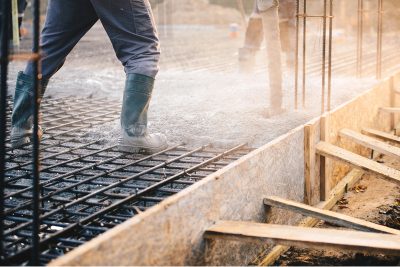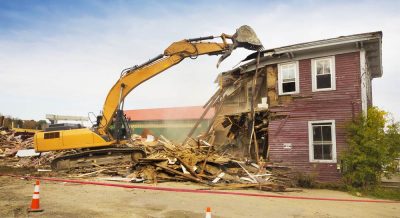- Oneflare /
- Cost Guides /
- Concrete Driveway

How much does a driveway cost?
$25 - $100 per m2
What's on this page
- How much does a driveway cost?
- Concrete driveway cost?
- The concrete driveway process
- 10 steps for laying new concrete
- Factors impacting the cost of a driveway
- Cost for different types of driveways
- Does the cost differ based on location?
- How to create an accurate estimate
- How to hire a concreter
- How to save when hiring a concreter
Read Related Concrete Driveway Articles
How much does a driveway cost?
Residents in Australia can expect to pay about $2,000 for a standard 30 square metre concrete driveway or approximately $65 per square metre, which includes both materials and labour.
How much does a concrete driveway cost?
The cost for a concrete driveway in Australia depends on a few factors such as size, decorations, and finishes. For example, a 21 square metre concrete driveway on level ground using standard premixed concrete without curves, decorations and minimal groundwork will cost about $1,500 plus GST. If your driveway is sloped, you can expect to add another $10 per square metre. Additionally, if you have existing driveways, removal and excavation can drive the cost up to $95 to $150 per square metre or more.
The concrete driveway process
There are generally two types of situations for driveways. Either you’re installing a new one, or you need to remove an existing driveway before the new one goes down. The process for a new driveway is straight forward with heavy machinery that grades and prepares the soil for the concrete, and the other method to remove an existing driveway involves a lot of work.
There’s more to the removal process than you may think. Some considerations include the equipment needed for the excavation of the old concrete, removal of the debris and licenses to operate heavy machinery.
Excavation and removal of debris
Most concreters prefer the use of a skid loader with a bucket and jackhammer to break up and remove the broken pieces of concrete. The old driveway is usually loaded into dump trucks and taken to a proper waste facility. Other circumstances may involve handheld jackhammers, picks, and shovels to reach smaller areas. However, sometimes a backhoe may be required to excavate hidden boulders or culverts.
Unless you own heavy equipment and have the licences to operate, you will need to hire a professional concreter to remove an existing concrete driveway and adequately dispose of the debris.
10 steps for laying new concrete
The process of laying new concrete is quite complicated as there are many factors to consider. How well your driveway performs and looks over the long-term will come down to the quality of the groundwork, materials, and artistry. To ensure a good-looking driveway that will also stand the test of time, make sure that your concreter utilises the following steps.
Step 1: A properly prepared subgrade
An adequately prepared subgrade will provide robust support and even slab thickness. It’s also a key component in preventing structural cracking and slab settlement. Soil compaction and composition of the soil are also critical. If your land has weak spots, they should be removed and filled with crushed rock or gravel. Additionally, depending on the condition of the soil and size of the slab, 20mm to 60mm of the crushed rock should be applied for an adequate subgrade.
Step 2: Spraying the subgrade
Concrete should not be poured on a bone-dry subgrade. The subgrade should be sprayed with water before the concrete is poured. This prevents the fresh concrete from wicking water and curing too fast. Which in the end, provides a higher quality slab.
Step 3: Properly mixed concrete
Properly mixed concrete will impact the longevity and performance of a concrete driveway. Utilising a cement truck is the best method of ensuring that your concrete is incorporated correctly.
Step 4: Control joints
Control joints should be installed at a maximum spacing of three metres for a 400mm thick driveway slab. The depth of the control joints is also essential. Your concreter should saw cut them about one quarter the thickness of the slab (100mm for a 400mm slab). Additionally, isolation joints should be incorporated where the driveway meets a garage floor slab, carport slab, sidewalk, and other existing pavements. You can ask your concreter to provide a jointing plan as part of their written job quote.
Step 5: Reinforcement
Your concreter must utilise steel reinforcement such as wire mesh or rebar that forms a grid pattern. Support will not stop cracks from occurring, but it will keep the slab together if cracking does occur. You may also want to talk to your concreter about adding synthetic fibres as they have been proven to reduce cracking in concrete driveways.
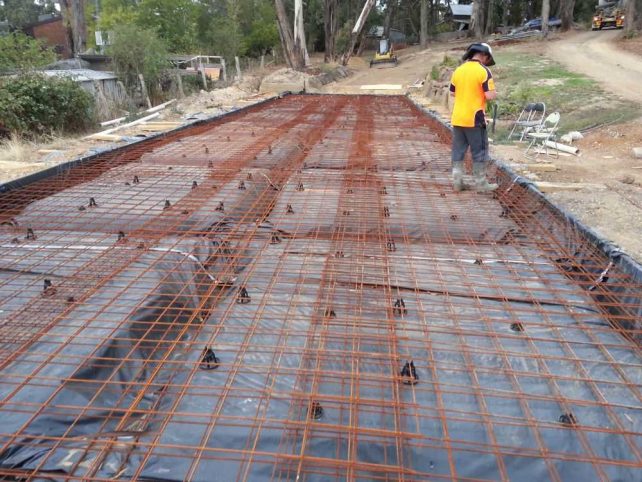
Steel mesh for a large driveway is assessed by concreting professional. | Source: Mcc Melbourne Concrete Company
Step 6: Pouring the proper thickness
Pavements specifically for foot traffic usually have a minimum thickness of 75mm. The minimum thickness of a concrete driveway in Australia is 100mm for vehicles that weigh less than 3 tonnes. This thickness is adequate for one or two vehicles; however, what if you have larger trucks or RVs? You should consider increasing the thickness. Adding depth will add to the cost of the driveway, but it also increases the load capacity by 50%.
Step 7: Proper finishing
One of the biggest mistakes that occur on concrete driveways during the finishing process is performing finishing operations and overworking the surface while bleed water is still present. Finishing is typically a three-step process that includes levelling the concrete with a screed, using a bull float before the bleed water accumulates and applying a broom finish for better traction. Your plans may also call for stamping or other decorative finishes. In this case, an experienced concreter will know how and when to apply these techniques.
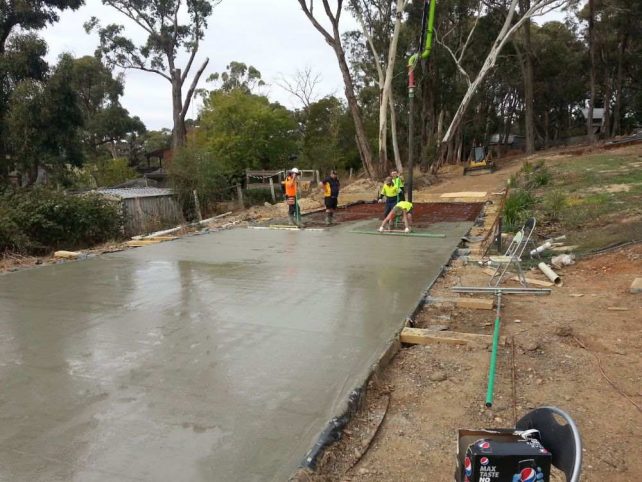
A leveller and trowel are used to smooth and level the concrete. | Source: Mcc Melbourne Concrete Company
Step 8: Proper drainage
A well-designed concrete driveway should not have standing water on it. Your driveway should be sloped away from existing structures. Depending on your existing conditions, a drain may need to be installed at the lowest point to collect and divert the water away.
Step 9: Proper curing techniques
The curing process of concrete is the final step for a concrete driveway, and it’s also the most crucial step. A concrete driveway that isn’t cured correctly after finishing can reduce its strength by 50%; therefore, making it more susceptible to cracking and surface defects. Some of the best curing techniques include the use of wet curing blankets or plastic sheets over the finished concrete with continuous sprinkling.
Step 10: Time frame for use
While foot traffic isn’t a problem after a couple of days of curing, you should wait at least seven days before you park on your new driveway. Concrete will reach 90% of its strength after seven days; however, for heavy and large vehicles or machinery, you should wait at least 30 days before use.
Factors impacting the cost of a driveway
As mentioned above, the cost of concrete driveway factors includes certain variables that impact the price such as the slope of the land, access to the site, demolition and the removal of existing driveways.
Season – The time of year also impacts the price. For example, concrete can be poured during the summer and winter; however, both require individual mixes while spring and fall provide the best weather conditions. This does impact the cost as concreters are extremely busy during peak seasons.
Additions to your driveway – Some other factors that will impact the price include adding a carport or gate to your driveway. To figure out the carport cost, you can expect to pay about the same price per square metre as your driveway. Driveway gate prices for single and double timber gates can range between $450 and $1,200 while wrought iron and elaborate gates will cost significantly more.
Materials – The type of concrete used and the materials employed affect the cost. For example, stamped or stencilled concrete generally costs more than standard concrete, while using materials such as Lilydale toppings can add to the overall expense of the project. If you choose to lay Lilydale toppings yourself to save on costs, it’s important to follow best practices such as subgrade preparation and compaction, to ensure proper drainage and durability of the driveway.
List of estimates for different types of driveways
Material of driveway
Although there are many options for driveways in Australia such as timber sleepers, clay brick pavers, and bluestone pavers. Plain concrete with either a smooth or brushed finish or exposed aggregate are the preferred choices for most Aussies. Below are some average estimates for the different types of driveway materials commonly found in Australia:
| Type of driveway | Average reported cost per square metre |
| Concrete driveway cost | $65 – $90 |
| Asphalt driveway cost | $25 – $40 |
| Bitumen driveway cost | $25 – $40 |
| Paver driveway cost | $40 – $100 |
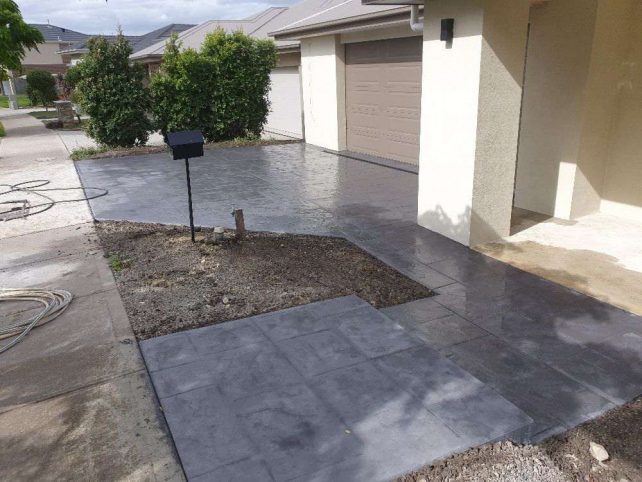
Recently completed concrete driveway and path. | Source: Goldmac Concrete Pty Ltd
Material of concrete driveway
Some other considerations that impact the overall cost of a concrete driveway are the decorations and finishes. A plain concrete driveway will always be less expensive than intricate and elaborate designs. Below are some estimates on what you can expect to pay for these different types of finishes:
Plain concrete driveway price – A plain concrete driveway will cost about $65 per square metre, and it provides a wide range of finishes.
Coloured concrete driveway price – A coloured concrete driveway is created by adding a colouring pigment to the water, and you can expect to pay between $75 to $90 per square metre.
Stamping concrete driveway price – A stamping concrete driveway consists of stamping the concrete with designs that imitate the look of bricks, pavers or stones. Stamping a concrete driveway will cost between $100 and $150 per square metre.
Exposed aggregate driveway cost – An exposed aggregate driveway, also known as pebblecrete is a popular decorative effect that reveals the stones in the concrete. You can expect to pay between $100 and $150 per square metre for an exposed aggregate driveway.
Resurfacing concrete cost – Perhaps you may only need to resurface your driveway. The cost varies depending on the type of concrete you have or choose. Resurfacing costs can start from $30 per square metre for plain concrete and up to $150 per square metre for exposed aggregate driveways.
| Types of concrete driveways | Average reported cost per square metre |
| Plain concrete | $65 |
| Coloured concrete | $75 – $90 |
| Stamping concrete | $100 – $150 |
| Exposed aggregate | $100 – $150 |
| Resurfacing | $30 – $150 |
Does the cost differ based on location?
You can find the lowest concreting prices in the capital territory of Canberra with an average cost of $30 per square metre. For homeowners in Victoria, you can expect to pay about $35 per square metre for the same concreting services. Meanwhile, residents in Queensland and South Australia will pay about $35 per square metre.
The highest concreting rates can be found in New South Wales with an average price of $40 per square metre, and Western Australia comes in at $45 per square metre. It’s also important to remember that excavation and removal of existing driveways can drive the cost up to $65 per square metre or more.
| State | Averaged reported cost per square metre |
| Canberra | $30 |
| Victoria | $35 |
| Queensland | $35 |
| South Australia | $35 |
| New South Wales | $40 |
| Western Australia | $45 |
Tips on how to create an accurate estimate before you start the project
To create an accurate estimate, you should use the following tips below before you start your concrete driveway project:
Tip #1: You should have an on-site inspection done and obtain multiple quotes on your driveway by calling professional landscapers or concreters. They can also give you additional advice and make suggestions on the best approach.
Tip #2: You will need to have accurate measurements of the driveway as well as how many cars you need to park on it.
Tip #3: During your on-site inspection, you should gather information on what’s the best slope design for your driveway. Depending on the length of your driveway and current landscape conditions, you will need either a slight or steep slope incorporated into the design.
Tip #4: You should consult with your local Council to understand the minimum and maximum requirements for driveways and obtain required permits.
Tip #5: If you have an existing driveway that needs removal, you should be prepared to pay more because demolition and removal of debris will significantly increase the cost.
How to hire a concreter
Before you hire a concreter, it’s essential to know if a tradie needs to be licensed in your state or not. Every state in Australia except for the Northern Territory and Tasmania require concreters to hold a concreting license. When it comes to hiring a concreter, you want the right tradie for your job. You can ask them some valid questions that include:
- Do you hold a concreter’s license?
- Can you provide a copy of your insurance?
- Do you provide written quotes with a jointing plan?
- Do you have photos of your previous work?
- Do you have references that I can call?
Tips on how to save money when hiring a concreter
There are a few tips that can save you money when hiring a concreter; however, don’t sacrifice the quality of your driveway by hiring a tradie with the lowest quote. Instead, you can use the tips below to save money on your concrete driveway:
Tip #1: Set yourself a budget, and select the materials that best suit your driveway and budget.
Tip #2: Get multiple quotes from concreters and choose one that comes within your budget.
Tip #3: If you have an existing driveway, consider your options for self-removal and disposal of debris.
Tip #4: Don’t obtain quotes during the peak season. Instead, get your quotes in the offseason and schedule your driveway for the upcoming peak season.
Tip #5: Select the best concreter in your local area because trucking equipment and materials from further distances can significantly add to the overall cost of your project.
* The cost data is based on Oneflare and third-party sources

